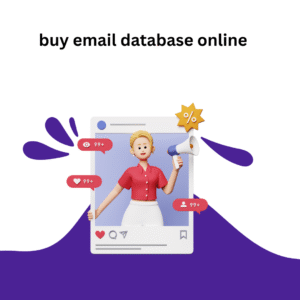Email marketing is a powerful tool for businesses. Indeed, it helps you talk to customers and share important news. Many businesses want to reach more people quickly. Therefore, they think about buying email databases online. However, this is usually a bad idea. There are many problems with buying email lists. It can hurt your business in the long run. Instead, building your own list is much better. This article explains why you should avoid buying email databases. It also shows how to grow your email list the right way Why Buying Email Databases.
What Are Email Databases and Why Do People Buy Them?
An email database is simply a list of email addresses. These lists are sometimes sold by companies online. People buy them hoping to send many emails at once. They want to reach a large group of potential customers fast. It seems like an list to data easy way to start email marketing. Also, it can feel like a shortcut to finding new customers. Many believe it will save time and effort. Thus, they choose to purchase these lists rather than building their own.
The Temptation of Quick Growth
It’s natural for businesses to want quick growth. Therefore, buying an email list appears to be a fast solution. You get a huge list of contacts almost instantly. This can make you feel like you are ready to start selling right away. Furthermore, it feels like a way to skip the hard work of finding individual leads. However, this speedy approach often hides many hidden dangers. These dangers can cost you a lot more than money.
How These Lists Are Made
Often, bought email lists are made by “scraping” the internet. This means software collects email addresses from websites. Sometimes, these lists are old or have fake addresses. They might also combine emails from many different sources. This means the people on the list probably don’t know you. They also haven’t agreed to get emails from your business. This lack of permission is a very big problem. It breaks trust and can lead to many issues.
The Big Problems with Buying Email Databases
There are many reasons why buying email lists is harmful. These problems affect your business, your reputation, and your money. It’s truly important to understand these risks. Otherwise, you might face serious trouble later on.
Legal Troubles and Breaking the Law
One of the biggest problems is legal issues. Many countries have laws about sending emails. For example, the CAN-SPAM Act in the USA sets rules the magic of html email marketing for commercial emails. Similarly, the GDPR (General Data Protection Regulation) in Europe is very strict. These laws protect people from unwanted emails. They say you must have permission to send marketing emails.
When you buy a list, the people on it haven’t given you permission. Therefore, sending them emails can be against the law. You could face big fines. These fines can be very expensive. Furthermore, your business could get a bad name. This is a risk no business should take. It’s always best to be on the right side of the law.
Damaged Reputation and Trust Issues
Imagine getting emails from a company you’ve never heard of. You probably wouldn’t be happy. Most likely, you’d mark it as spam. This is exactly what happens with bought lists. People get emails they didn’t ask for. They see it as spam. Consequently, they lose trust in your brand.
When many people mark your emails as spam, it hurts your sender reputation. Email providers like Gmail or Yahoo notice this. They might mobile lead start sending all your emails to the spam folder. This means even your good emails won’t reach your real customers. Your brand looks unprofessional. Trust is hard to build but easy to lose. Thus, protect your brand’s good name.
Low Quality and Useless Emails
Purchased lists often have very low-quality email addresses. Many addresses might be old or fake. Some might be “spam traps,” which are set up to catch spammers. Sending emails to these addresses wastes your time and resources. You pay for a list that doesn’t help you.
Furthermore, these lists are rarely targeted. This means they include people who have no interest in your products. Sending them irrelevant emails is pointless. They won’t open your emails or buy from you. Instead, they will simply ignore or delete your messages. This leads to very low open rates and click-through rates.
High Bounce Rates
A high bounce rate means many of your emails don’t get delivered. This happens when addresses are fake or don’t exist. Email services see high bounce rates as a sign of spamming. They might block you. So, a high bounce rate is very harmful. It signals to email providers that your list is bad.
No Engagement, No Sales
Even if emails get delivered, people on bought lists rarely engage. This means your email marketing efforts are wasted. You spend time and money for no return.</span> Your return on investment (ROI) will be very low, or even negative.
Building Your Own Email List: The Right Way
Instead of buying lists, build your own. This is called organic list building. It takes more time, but it’s far more effective. You gather emails from people who truly want to hear from you. This creates a strong, engaged audience. They are more likely to become loyal customers.

Offer Something Valuable (Lead Magnets)
People will give you their email address if you offer them something useful. This is called a lead magnet. It could be a free guide, an ebook, a checklist, or a discount. Make sure your lead magnet solves a problem for your audience. It should be truly helpful.
For example, a cooking blog could offer a free recipe book. A fitness coach might offer a workout plan. When people get something valuable, they’re happy to share their email. This builds a good relationship from the start.
Use Signup Forms on Your Website
Place clear signup forms on your website. Make them easy to find. You can have them in your website’s header, footer, or sidebar. Pop-up forms can also work well if used carefully.
Ensure the forms are simple. Ask only for their name and email address. Too many questions might scare people away. Always explain what they’ll get by signing up. For instance, “Join our newsletter for weekly tips and exclusive discounts!”
Create Great Content
Good content makes people want to hear from you. Write blog posts, articles, and videos that help your audience. Share useful information. When people enjoy your content, they will want more.
They will be more likely to sign up for your email list. Share your expertise. Be helpful. This shows your brand is trustworthy and knowledgeable. Engaging content also encourages people to share your emails.
Promote on Social Media
Use your social media channels to promote your email list. Share links to your signup forms. Talk about the benefits of joining your list. You can run contests or giveaways that require an email signup.
Social media is a great way to reach a wider audience. Direct them to your website to sign up. Encourage your followers to join your email community. This expands your reach effectively.
Collect Emails at Events
If you attend or host events, collect emails there. You can have a signup sheet or an iPad for signups. Always ask for permission first. Explain why you want their email and what they will receive.
This is a direct way to connect with interested people. They’ve met you or seen your product. Therefore, they are more likely to be interested. This personal touch builds stronger connections.
Best Practices for Email Marketing Success
Once you have a good email list, you must use it wisely. There are many ways to make your email marketing effective. These tips help you keep subscribers happy and engaged. They also help you get better results.
Segment Your Email List
Don’t send the same email to everyone. Divide your list into smaller groups. This is called segmentation. For instance, you can group people by their interests, past purchases, or location.
Sending tailored emails works much better. A person interested in dog food doesn’t want emails about cat toys. Personalized content makes emails more relevant. This leads to higher open rates and more sales. It shows you understand your audience.
Personalize Your Emails
Use the person’s name in the email. Talk about things they care about. This makes your emails feel more personal. It makes the reader feel special, not just one of many.
Personalization goes beyond just using their name. It means sending content that truly matters to them. For example, if someone bought a certain product, send them related tips. This makes your emails more engaging.
Send Engaging and Useful Content
Every email you send should offer value. It shouldn’t just be sales pitches. Share tips, news, stories, or exclusive content. Make your emails interesting to read.
Keep your sentences short and easy to understand. Use clear language. This keeps readers hooked. Always remember to provide value. If your emails are consistently useful, people will look forward to them.
Make Unsubscribing Easy
It might seem strange, but making it easy to unsubscribe is important. If someone wants to leave your list, let them. Don’t hide the unsubscribe link. This builds trust.
If people can’t easily unsubscribe, they might mark your emails as spam. This hurts your sender reputation. A clear unsubscribe option shows you respect their choices.
Clean Your List Regularly
Remove inactive subscribers from your list. These are people who never open your emails. Sending emails to inactive contacts hurts your deliverability. It makes your open rates look bad.
Cleaning your list helps keep it healthy. It improves your email performance. Focus on quality, not just quantity. A smaller, engaged list is always better than a large, inactive one.
The True Cost of Email Marketing
Email marketing is very cost-effective. It gives a great return on investment. Businesses often make a lot of money for every dollar spent on email marketing. However, this is true for organic lists, not bought ones.
Investing in Tools and Time
You’ll need an email marketing service like Mailchimp or Constant Contact. These tools help you send emails, manage your lists, and track results. They usually have different pricing plans based on how many subscribers you have.
The biggest investment is your time. It takes effort to create good content and build a list. But this effort pays off in the long run. It builds a loyal customer base.
Email Marketing ROI
Email marketing has a high ROI. For every $1 spent, businesses often get $36 or more back. This is because email allows direct communication with interested people. When done correctly, email marketing is a powerhouse. It drives sales and builds strong customer relationships.
